Table of Contents
SaaS Management is no longer optional. For IT, Software Asset Management (SAM), and Procurement teams, it’s become a foundational function for controlling costs, managing risk, and maximizing value across the organization. The average company now uses hundreds of SaaS applications, and software spend continues to climb year over year. In this environment, visibility and control are non-negotiable.
A reliable SaaS system of record is where effective SaaS Management begins. Without a central, up-to-date repository of information about your applications—what they are, who’s using them, how much they cost—every decision you make is based on assumptions. Optimization becomes guesswork. Renewals happen without context. And strategic alignment between departments suffers.
A well-maintained system of record brings clarity. It transforms scattered data into actionable insights, guiding decisions that reduce waste, improve compliance, and ensure software investments are aligned with business goals.
What Is a SaaS System of Record?
A SaaS system of record is your single source of truth for managing your organization’s software ecosystem. It acts as a centralized, living inventory that consolidates critical data across all SaaS applications—costs, usage metrics, license entitlements, contract terms, ownership assignments, and renewal timelines.
This system goes beyond basic app lists or spreadsheets. It continuously tracks and updates key attributes to reflect your actual software environment. With a complete and accurate view, your team can evaluate utilization, avoid redundant tools, manage renewals, and confidently control spending.
Teams across IT, Procurement, and SAM rely on this record to drive decision-making. Whether it’s justifying a license consolidation, preparing for an audit, or evaluating vendor performance, the system provides the context needed to act efficiently and strategically.
Without a SaaS system of record, organizations are more likely to experience overspending, compliance gaps, and security risks—especially as decentralized purchasing grows. A well-maintained system doesn’t just support software management. It underpins long-term planning by offering real-time, trustworthy data across the SaaS lifecycle.
Why a Maintained System of Record Is Essential
Building a SaaS system of record is a foundational step—but maintaining it is where the real impact lies. SaaS environments are highly dynamic. New applications are constantly being added (7.6 on average per month), contracts are renegotiated, ownership changes hands, and tools fall out of use. If your system of record isn’t updated in real time, it quickly becomes outdated, creating blind spots that hinder decision-making.
The 2025 SaaS Management Index reveals that organizations now manage an average of 275 SaaS applications and spend approximately $49M per year on SaaS. Even more striking: 74% of that spend is initiated outside IT, driven by business units and departments through decentralized purchasing.
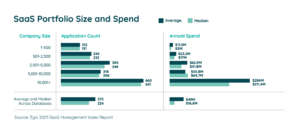
That level of complexity and fragmentation requires strong, centralized visibility. A maintained system of record ensures your team is tracking the complete picture—not just what’s visible to IT. It helps you capture spend outside traditional procurement channels and align your software portfolio with broader organizational goals.
The Impact of Inaccurate SaaS Data
When your SaaS data isn’t current, the consequences go far beyond a few duplicate licenses or outdated app names. Incomplete or inaccurate data introduces risk at every stage of the software lifecycle. Budgeting becomes imprecise, and forecasting is unreliable. Renewal decisions are made without full context—or worse, not made at all.
A common consequence of stale data is getting locked into auto-renewals for unused applications, a scenario that leads to unnecessary costs and missed opportunities for renegotiation. Missed renewals can mean you’re automatically committed to another year of licensing for tools that no longer serve the business. Likewise, outdated ownership records can result in no one being accountable for contracts, usage tracking, or compliance documentation.
Here are just a few of the risks that come from relying on outdated or incomplete SaaS data:
- Auto-renewals on unused or underutilized tools
- License overages due to poor tracking of entitlements vs. actual usage
- Security exposure from unmonitored or unsanctioned applications
- Compliance failures stemming from expired agreements or a lack of audit trails
- Redundant tools that inflate spend without delivering added value
These challenges only intensify as SaaS portfolios grow. Maintaining your system of record ensures that your organization stays in control—financially, operationally, and strategically.
Enabling Smarter Business Decisions
When your SaaS system of record is consistently updated, it becomes more than a data repository—it becomes a decision-making engine. With real-time visibility into cost, utilization, ownership, and renewal dates, your teams gain the insights to take timely, informed action. The ability to assess application performance and usage against actual business needs enables confident decisions that directly impact cost savings and operational efficiency.
Here are a few examples:
- License utilization data helps identify underused or unused licenses that can be reclaimed, reallocated, or eliminated.
- Usage trends can reveal overlapping functionality across multiple tools, allowing you to consolidate applications and reduce redundancy.
- When shadow IT is uncovered, you can evaluate those tools for security and compliance before they become liabilities.
One Zylo customer achieved significant savings by analyzing collaboration tool usage across departments. They discovered multiple teams using similar applications with overlapping capabilities. By consolidating those tools into a single, standardized platform, they reduced licensing costs and improved interdepartmental communication and user experience.
Driving Alignment Across Teams
A centralized, accurate SaaS system of record creates a shared foundation for cross-functional collaboration. When IT, SAM, Procurement, Finance, and department leaders all work from the same data, silos begin to dissolve. Everyone speaks the same language—one grounded in facts, not assumptions.
This transparency supports faster, more aligned decisions. Procurement can evaluate renewals with confidence. Finance can validate forecasts and budget more accurately. IT can manage security risks tied to unmanaged or non-compliant tools. Business leaders can also assess how software investments align with team goals and company-wide priorities.
Equally important, accurate data builds trust with executive sponsors. With a clear view of spend trends, risk exposure, and application performance, leadership can make strategic investments that support growth while reducing waste. A maintained system of record makes these insights easy to surface, reinforcing the value of your SaaS Management program at every level of the organization.
Aligning SaaS System of Record with Business Goals
Maintaining your SaaS system of record isn’t just an operational task—it’s a strategic enabler that directly supports company-wide objectives. Clean, accurate data empowers leaders to make informed decisions that drive growth, manage risk, and adapt to change. Consistently maintaining your system of record becomes a critical input for long-term planning across departments.
Digital Transformation and M&A
For organizations undergoing digital transformation or preparing for mergers and acquisitions, trustworthy SaaS data is indispensable. Leadership teams need to understand the full scope of their software footprint—what tools are in use, where overlap exists, and how each application supports business operations. Without this visibility, transformation initiatives risk being delayed or derailed by unknown redundancies or integration gaps.
“Having an instance of Zylo for Marigold and the acquired company allows us to connect to their finance systems and pull in that data, and then we’re doing an instant-compare of what tools are the exact same.”
— Karen Hodson, Global Real Estate & Procurement Office at Marigold
Financial Stability
From a financial perspective, the benefits are just as clear. CFOs and finance teams increasingly demand greater accountability around software spend. Accurate SaaS data supports better forecasting, streamlines budget planning, and provides concrete evidence for optimizing costs. Rather than relying on assumptions or siloed reports, finance leaders can model future spend based on real usage patterns and ownership data.
Innovation
Maintaining software visibility also enables innovation. With a clear view of what’s in place and how tools are performing, organizations can make space for experimentation. When redundant or low-value applications are removed, budget and bandwidth open up for piloting new tools that drive competitive advantage.
By aligning the SaaS system of record maintenance with business goals, organizations move beyond simple asset tracking. They build a software strategy that evolves with the business—one grounded in actionable, organization-wide insight.
The No-BS SaaS Management Playbook
Learn MoreWho Owns the System of Record? Establishing Clear Roles
Cross-functional alignment is only effective when paired with clear ownership. To keep your SaaS system of record accurate and actionable, someone—or more often, some team—must be accountable for managing it. Without defined roles and responsibilities, data becomes stale, updates fall through the cracks, and strategic value is lost.
Ownership doesn’t have to rest with a single individual, but it does require a defined structure. Many organizations designate a data steward or platform administrator within IT or SAM to serve as the primary point of contact for system maintenance. This role ensures that updates are made regularly, discrepancies are resolved, and new applications are documented as they enter the environment.
Cross-Functional Oversight Strengthens Accountability
A system of record supports the entire organization, so its maintenance should reflect that shared responsibility. Establishing a governance model that includes stakeholders from IT, Procurement, SAM, and even Finance can help ensure the system stays aligned with business priorities. This group can define policies around who enters data, how updates are approved, and when the system should be reviewed.
To support this structure, many teams use change logs, approval workflows, or internal ticketing systems to track adjustments to the system of record. Whether updating a license count, assigning new ownership, or flagging an application for renewal review, these workflows reduce friction and improve transparency across teams.
For organizations using Zylo, built-in capabilities like automated workflows, update logs, and renewal coordination tools help operationalize system management at scale, reducing manual effort while ensuring data accuracy.
A maintained system of record is only as strong as the structure behind it. With defined ownership and collaborative oversight, your organization can keep its SaaS data accurate, reliable, and strategically valuable.
The Cost of Inaction: What Happens Without a Maintained System of Record
Even with the right ownership model in place, the true risk lies in inaction. A system of record that isn’t actively maintained quickly becomes outdated—and the consequences reach far beyond inaccurate data. The longer it goes unmanaged, the more risk, waste, and inefficiency it introduces across the organization.
Financial and Operational Costs Escalate Quickly
The most visible impact is financial. Without up-to-date license data, organizations often pay for tools that no longer serve a purpose. Duplicate applications, overlapping functionality, and unused seats go unnoticed, inflating software spend without adding value. Many teams also fall into the trap of missed renewal reviews, leading to license waste and auto-renewals for tools no one is actively using.
But the hidden costs are just as significant. When data is unreliable, decision-making slows down. Leaders hesitate to act without confidence in what’s real, especially when budgeting, approving new tools, or evaluating vendor performance. Poor visibility creates friction between departments and makes it harder to align technology investments with strategic priorities.
The following data points illustrate the scale of these financial risks:
- The average company spends $49M per year on SaaS, with portfolio growth averaging 33%. When new apps are added without old ones being canceled, an increasing app count means increasing spend.
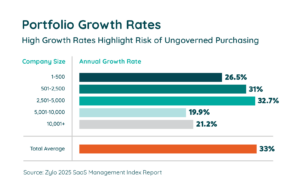
- On average, companies use just 47% of their software licenses. Over the course of a year, this adds up to an average of $21M in wasted spending.
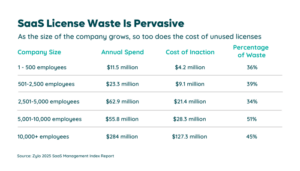
- If you consider the top three most redundant application functions; online training classes, project management, and team collaboration; there’s an average of $477K to $2.8M in potential cost savings.
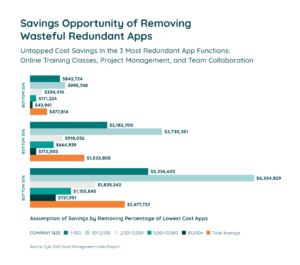
- According to Gartner, through 2027, organizations that fail to attain centralized visibility and coordinate SaaS life cycles will overspend on SaaS by at least 25% due to unused entitlements and unnecessary, overlapping tools.
Risk Exposure
Security and compliance risks also increase. Unmonitored applications can introduce vulnerabilities, especially if they’re no longer supported or fall outside governance policies. Without clear records of ownership and usage, audits become more difficult—and risk exposure becomes harder to control.
For example, our 2025 SaaS Management Index shows that more than half of applications in the average portfolio are considered risky. Based on Netskope’s Cloud Confidence Index, 51% of apps have a “Poor” or “Low” risk score, meaning they introduce significant security and compliance risks to organizations.
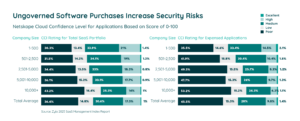
Missed Optimization Opportunities Add Up
Finally, opportunities for optimization are often missed. When software portfolios aren’t reviewed regularly, organizations lose leverage in vendor negotiations and consolidation efforts. A contract might auto-renew at full price simply because no one had accurate data to evaluate alternatives in time.
The average company experiencing 247 renewals each year—or one per business day. So it’s critical to have an constantly updated system of record to find and take action on opportunities to optimize your software spending and stack.
The cost of inaction adds up quickly. Maintaining your system of record isn’t just about staying organized. It’s about protecting your budget, security posture, and ability to make strategic, data-driven decisions.
Real-World Results: What a Maintained System of Record Unlocks
Maintaining an accurate SaaS system of record empowers organizations to optimize costs, enhance vendor negotiations, and improve strategic decision-making. Here are real-world examples from Zylo customers who have realized significant benefits:
Reclaiming Unused Licenses for Significant Cost Avoidance
Modernizing Medicine (ModMed) leveraged Zylo’s deprovision workflows to reclaim 2,800 unused licenses, resulting in $1.4 million in cost avoidance. By automating the identification and reclamation of underutilized licenses, ModMed effectively reduced waste and optimized its SaaS investments.
Enhancing Vendor Negotiations with Comprehensive SaaS Visibility
A leading software firm utilized Zylo’s platform to gain visibility into over 170 SaaS applications. This comprehensive insight enabled them to consolidate contracts and negotiate improved pricing, leading to substantial cost savings. By standardizing applications under a single organization-wide contract, they achieved immediate financial benefits.
Streamlining SaaS Management and Strengthening Cross-Functional Collaboration
Talkdesk’s IT and procurement teams used Zylo to capture all contracts and tools, allowing for a more strategic evaluation of their global toolset. This approach improved collaboration between departments and enhanced their ability to manage SaaS growth effectively.
These examples demonstrate the tangible benefits of maintaining a robust SaaS system of record. Organizations can drive cost savings, negotiate better vendor terms, and make informed strategic decisions by ensuring accurate and up-to-date data.
Best Practices for Maintaining Your SaaS System of Record
Maintaining a SaaS system of record isn’t a one-time task—it requires consistent attention, intentional processes, and the right tooling to stay accurate over time. As your software portfolio grows and becomes more decentralized, proactive management is essential to ensure the system remains a reliable source of truth.
Here are four best practices that help organizations keep their SaaS system of record accurate, actionable, and strategically valuable.
Prioritize Ongoing SaaS Discovery
New tools enter the environment every day, often without IT’s involvement. In fact, decentralized purchasing across business units means many applications go untracked for months—introducing spend inefficiencies and security risks.
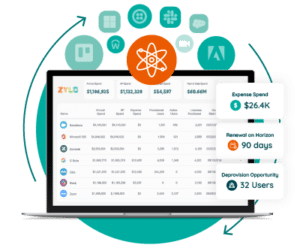 To maintain complete visibility, you need more than a manual process. Implement automated discovery tools that continuously monitor financial transactions, employee expense reports, and activity across SSO and identity provider platforms. This ensures you capture every application as it enters the organization, regardless of how or where it was purchased.
To maintain complete visibility, you need more than a manual process. Implement automated discovery tools that continuously monitor financial transactions, employee expense reports, and activity across SSO and identity provider platforms. This ensures you capture every application as it enters the organization, regardless of how or where it was purchased.
By prioritizing ongoing SaaS discovery, you reduce the risk of shadow IT and maintain a comprehensive, up-to-date inventory of your software ecosystem.
Standardize App Onboarding and Offboarding
Establishing a standardized process for bringing new applications into your environment—and retiring those no longer needed—helps eliminate inconsistencies and blind spots in your data.
Require all departments to register new software purchases with a centralized team or platform. Integrate license assignment into employee onboarding to ensure users have access only to the tools they need. Just as important, build license removal and access revocation into offboarding workflows to reduce security exposure and avoid license waste.
When onboarding and offboarding processes are aligned with your SaaS system of record, your data stays clean and your application lifecycle remains controlled.
Schedule Regular System Reviews
Keeping your system of record up to date isn’t just about automation—it also requires regular human oversight. Schedule monthly or quarterly reviews to validate the accuracy of key data points, including license counts, cost allocations, ownership details, and renewal timelines.
These checkpoints also allow you to reassess tool usage, identify contract changes, and ensure that each application still aligns with business needs. Regular reviews create a rhythm of accountability that reinforces long-term data integrity.
Use Your System of Record as a Strategic Asset
When consistently maintained, your SaaS system of record becomes a strategic enabler. Go beyond tracking applications. Use the data to evaluate vendor performance, monitor adoption rates, and align spend with outcomes.
Use insights from your system to guide consolidation strategies, inform negotiations, and forecast future needs. A clean, current data set allows you to assess where software is adding value, where it’s not, and where change is needed. This transforms your SaaS Management program from reactive to strategic.
Zylo Helps You Keep Your SaaS System of Record Up to Date
Once your system of record is in place, the real value comes from keeping it accurate over time—and that’s where Zylo excels. With built-in tools for discovery, license optimization, and renewal workflows, Zylo’s SaaS Management Platform helps ensure your system remains current and trustworthy as your software environment evolves.
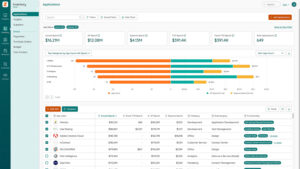
Automated discovery captures new applications as they’re introduced, license utilization insights highlight underused tools, and structured workflows bring transparency to renewals and ownership changes. With everything centralized and continuously updated, you can rely on your system of record to support decision-making across the organization.
Getting Started With Zylo
Zylo makes the setup and maintenance of your SaaS system of record seamless from the start. Whether your team is just beginning its SaaS Management journey or looking to improve existing workflows, Zylo provides the tools and support to get up and running quickly.
Guided onboarding ensures your system of record is built on accurate, comprehensive data from day one. Integrations with finance systems, SSO platforms, and identity providers simplify data collection, while intuitive dashboards and expert support reduce manual lift and accelerate time to value.
Want to see what’s possible with a maintained, automated system of record? Take an interactive tour of Zylo’s Inventory Management solution and explore how you can bring visibility, control, and strategy to your SaaS portfolio.

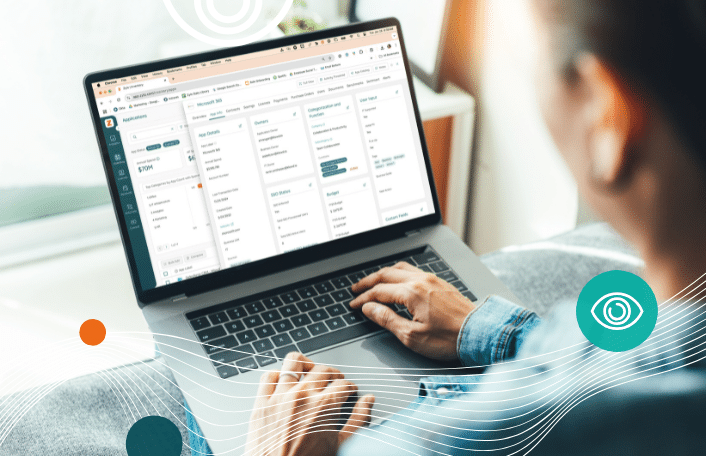
 — Karen Hodson, Global Real Estate & Procurement Office at Marigold
— Karen Hodson, Global Real Estate & Procurement Office at Marigold